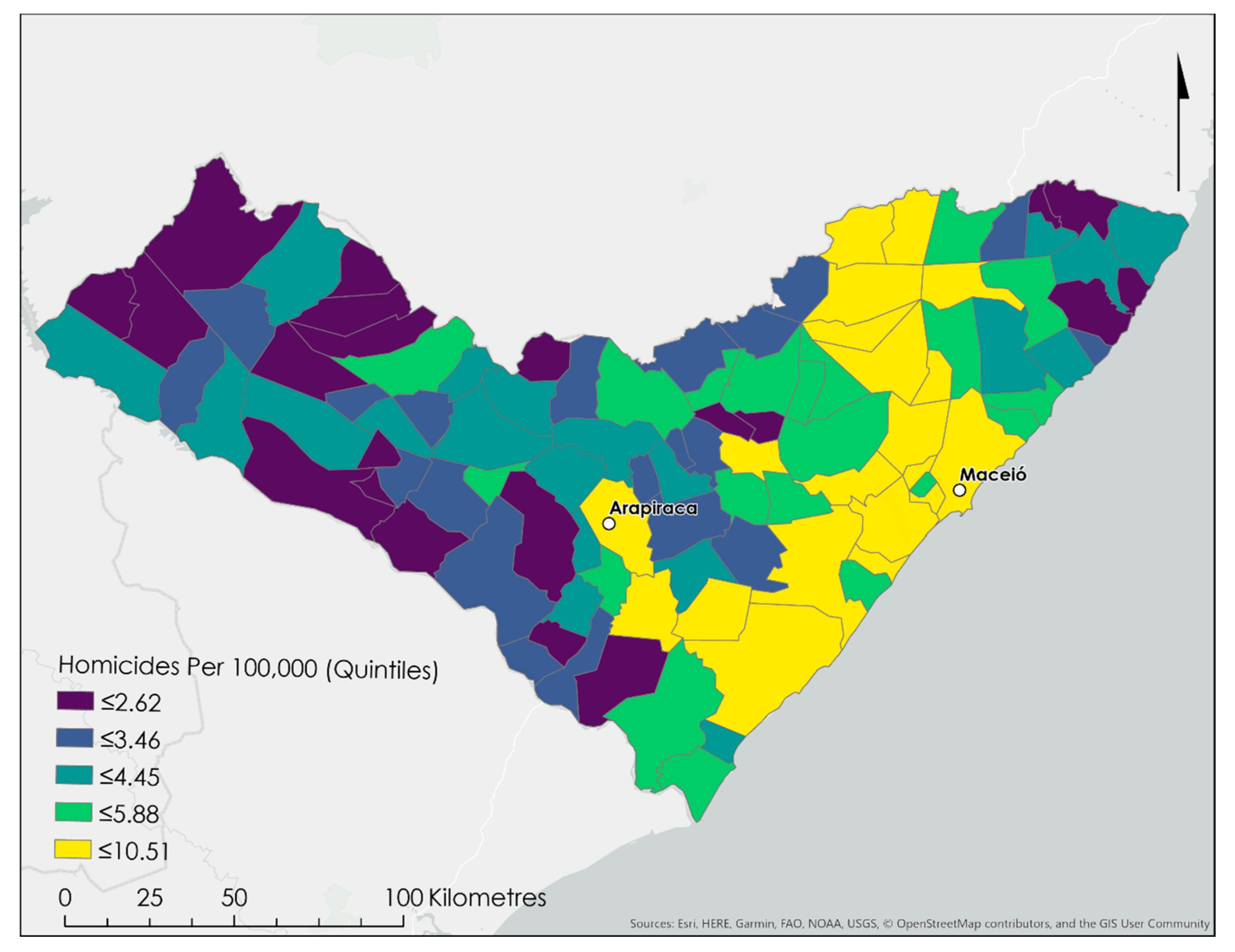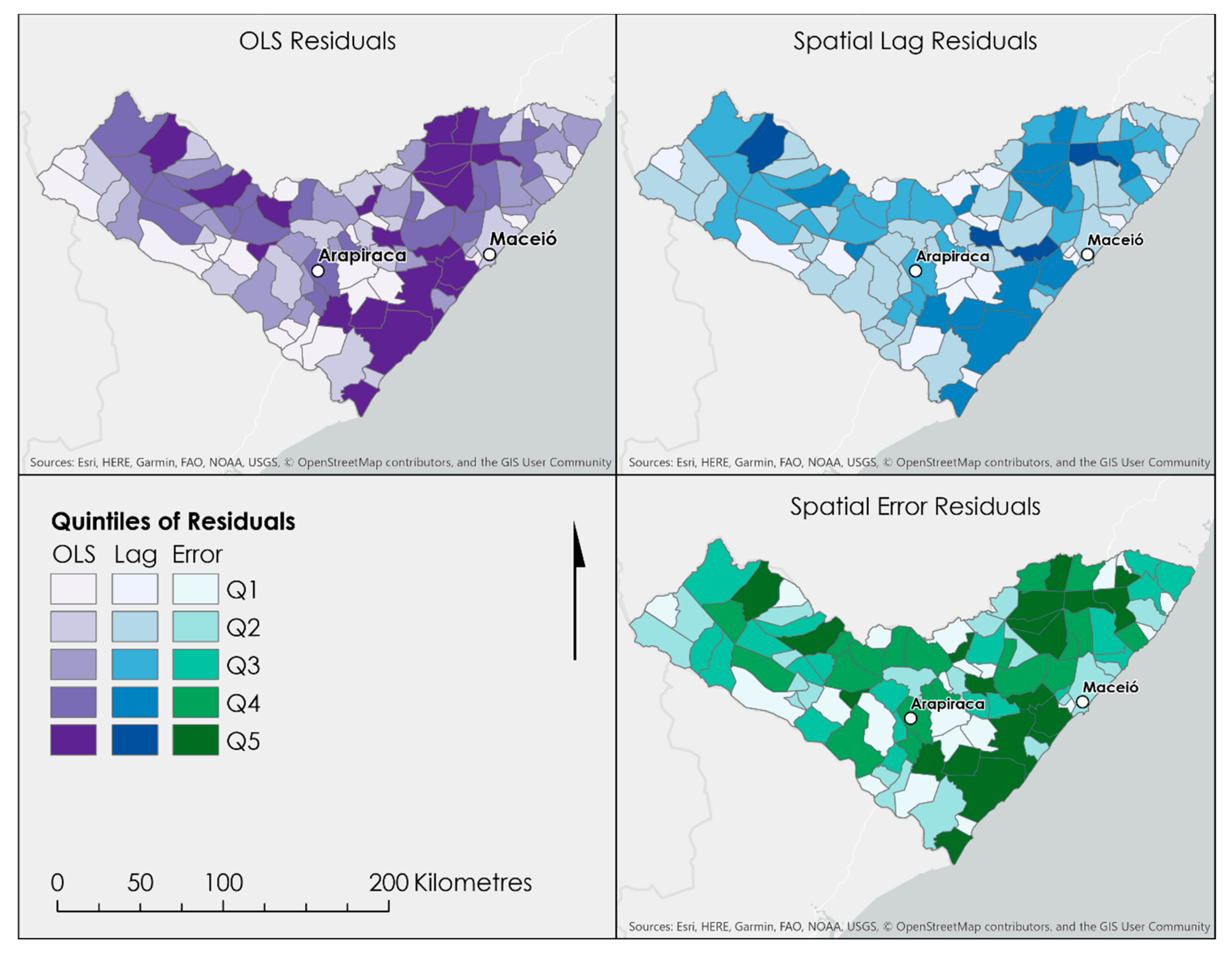Towards a Situated Spatial Epidemiology of Violence: A Placially-Informed Geospatial Analysis of Homicide in Alagoas, Brazil
Abstract
1. Introduction
1.1. Rationale
1.2. Empirical Context
1.3. Objectives
2. Materials and Methods
2.1. Qualitative Data
2.2. Quantitative Data
2.3. Modelling
3. Results
3.1. Qualitative Analysis
3.2. Quantitative Analysis
4. Discussion
4.1. Spatial and Socioeconomic Context
4.2. Reflection and Limitations
5. Conclusions
Author Contributions
Funding
Acknowledgments
Conflicts of Interest
References
- Elliot, P.; Wartenberg, D. Spatial Epidemiology: Current Approaches and Future Challenges. Environ. Health Perspect. 2004, 112, 998–1006. [Google Scholar] [CrossRef]
- Kwan, M.P. Beyond Difference: From Canonical Geography to Hybrid Geographies. Ann. Am. Assoc. Geogr. 2004, 94, 756–763. [Google Scholar]
- Kearns, R.; Moon, G. From medical to health geography: Novelty, place and theory after a decade of change. Prog. Hum. Geogr. 2002, 26, 605–625. [Google Scholar] [CrossRef]
- Prior, L.; Manley, D.; Sabel, C. Biosocial health geography: New ‘exposomic’ geographies of health and place. Prog. Hum. Geogr. 2019, 43, 531–552. [Google Scholar] [CrossRef]
- Rosenberg, M. Health Geography II: ‘Dividing’ Health Geography. Prog. Hum. Geogr. 2016, 40, 546–554. [Google Scholar] [CrossRef]
- Walker, B.B.; Schuurman, N. The pen or the sword: A situated spatial analysis of graffiti and violent injury in Vancouver, British Columbia. Prof. Geogr. 2015, 67, 608–619. [Google Scholar] [CrossRef]
- Barbosa, K.G.N.; Walker, B.B.; Schuurman, N.; Calvacanti, S.D.L.B.; Ferreira, E.F.; Ferreira, R.C. Epidemiological and Spatial Characteristics of Interpersonal Physical Violence in a Brazilian City: A Comparative Study of Violent Injury Hotspots in Familial versus Non-Familial Settings, 2012–2014. PLoS ONE 2019, 14, e0208304. [Google Scholar] [CrossRef]
- Eide, A.H.; Dyrstad, K.; Munthali, A.; Van Rooy, G.; Braathen, S.H.; Halvorsen, T.; Persendt, F.; Mvula, P.; Rød, J.K. Combining survey data, GIS and qualitative interviews in the analysis of health service access for persons with disabilities. BMC Int. Health Hum. Rights 2018, 18, 26. [Google Scholar] [CrossRef]
- United Nations Office on Drugs and Crime (UNODC). Global Study on Homicide: Executive Summary. 2019. Available online: https://www.unodc.org/unodc/en/data-and-analysis/global-study-on-homicide.html (accessed on 11 April 2020).
- Da Trindade, R.F.C.; de Costa, F.A.M.M.; de da Silva, P.P.A.C.; Caminiti, G.B.; Santos, C.B. Map of homicides by firearms: Profile of the victims and the assaults. Rev. Esc. Enferm. USP 2015, 49, 748–755. [Google Scholar] [CrossRef]
- Instituto Brasileiro de Geografia e Estatística (IBGE). Estimativas da População. Available online: https://www.ibge.gov.br/estatisticas/sociais/populacao/9103-estimativas-de-populacao.html (accessed on 9 September 2020).
- DataSUS. Ministério da Saúde do Brasil. Available online: https://datasus.saude.gov.br/ (accessed on 13 February 2020).
- Moura de Souza, C. Youth and Violence in Brazil: An ethnographical study on youth street violence related to drugs and social order in Brazil’s violent city of Maceió. In Understanding Retaliation, Mediation and Punishment: Collected Results; Timm, S., Yelva, A., Max Planck Institute for Social Anthropology, Eds.; IMPRESS Druckerei: Halle, Germany, 2019; pp. 151–157. [Google Scholar]
- Cavalcanti, A.R.C. Work, Slums, and Informal Settlement Traditions: Architecture of the Favela Do Telegrafo. Tradit. Dwell. Settl. Rev. 2017, 28, 71–81. [Google Scholar]
- Galvão, J.A.C. Desafios para a universalização dos serviços de água e esgoto no Brasil Desafios para a universalização dos serviços de água e esgoto no Brasil. Rev. Panam. Salud Públ. 2009, 25, 548–556. [Google Scholar]
- Marinho, C.; Flor, T.; Pinheiro, J.; Ferreira, M. Objetivos de Desenvolvimento do Milênio: Impacto de ações assistenciais e mudanças socioeconômicas e sanitárias na mortalidade de crianças. Cad. Saúde Públ. 2020, 36, 1678–4464. [Google Scholar] [CrossRef]
- Walker, B.B.; Schuurman, N.; Hameed, S.M. A GIS-Based Spatiotemporal Analysis of Violent Trauma Hotspots in Vancouver, Canada: Identification, Contextualisation and Intervention. BMJ Open 2014, 4, e003642. [Google Scholar] [CrossRef]
- Viotti de Costa, E. The Brazilian Empire: Myths and Histories; University of California Press: Oakland, CA, USA, 1985. [Google Scholar]
- Murray, J.; de Cerqueira, D.R.C.; Kahn, T. Crime and violence in Brazil: Systematic review of time trends, prevalence rates and risk factors. Aggress. Violent Behav. 2013, 18, 471–483. [Google Scholar] [CrossRef]
- Sachsida, A.; Cardoso de Mendonça, M.J.; Loureiro, P.R.A.; Sarmiento Gutierrez, M.B. Inequality and criminality revisited: Further evidence from Brazil. Empir. Econ. 2009, 39, 93–109. [Google Scholar] [CrossRef]
- Pickett, K.; Wilkinson, R. The Spirit Level: Why Equality is Better for Everyone; Allen Lane: London, UK, 2009. [Google Scholar]
- Beyer, K.; Wallis, A.B.; Hamberger, L.K. Neighbourhood Environment and Intimate Partner Violence: A Systematic Review. Trauma Violence Abus. 2013, 16, 16–47. [Google Scholar] [CrossRef] [PubMed]
- Santos Simone, M.; Barcellos, C.; Carvalho, M.S. Ecological Analysis of the Distribution and Socio-Spatial Context of Homicides in Porto Alegre, Brazil. Health Place 2006, 12, 38–47. [Google Scholar] [CrossRef] [PubMed]
- Daudelin, J.; Ratton, J.L. Illegal Markets, Violence and Inequality: Evidence from a Brazilian Metropolis; Palgrave Macmillan: Cham, Switzerland, 2018. [Google Scholar]
- Moura de Souza, C. A Cycle of Youth Street Violence in Maceió, Brazil; Max-Planck-Institut für Ausländisches und Internationales Strafrecht: Freiburg, Germany, 2018. [Google Scholar]
- Moura de Souza, C. Violência letal e tráfico de drogas em Maceió. Rev. Port. Ciênc. Crim. 2016, 26, 485–498. [Google Scholar]
- Carvalho, L.S.; Soares, R.R. Living on the edge: Youth entry, career and exit in drug-selling gangs. J. Econ. Behav. Organ. 2016, 121, 77–98. [Google Scholar] [CrossRef]
- Ursin, M. “Crack Ends it all?” A Study of the Interrelations between Crack Cocaine, Social Environments, Social Relations, Crime, and Homicide among Poor, Young Men in Urban Brazil. Contemp. Drug Probl. 2014, 41, 171–199. [Google Scholar] [CrossRef]
- Ávila, T.P. Facing domestic violence against women in Brazil: Advances and challenges. Int. J. Crime Justice Soc. Democr. 2018, 7, 15–29. [Google Scholar] [CrossRef]
- Rogers, T.D. The Deepest Wounds: A Labor and Environmental History of Sugar in Northeast Brazil; University of North Carolina Press: Chapel Hill, NC, USA, 2010. [Google Scholar]
- Rogers, T.D. Race, Respect, and Authority in Contemporary Brazil: Interpreting the Stories of Sugarcane Workers. Labor 2011, 8, 123–146. [Google Scholar] [CrossRef]
- Jones, T.A. Sugarcane Labor Migration in Brazil; Palgrave Pivot: Cham, Switzerland, 2020. [Google Scholar]
- Dammert, L. Gang Violence in Latin America; University of Santiago Chile: Santiago, Chile, 2017. [Google Scholar]
- MaristrelloPorto, A.J.; Butelli, P.H. Impacts of Divorce Law Changes in Brazil and the “Extinction” of Judicial Separation. Braz. J. Empir. Leg. Stud. 2016, 3, 149–161. [Google Scholar]
- Roberts, J.; Wolfer, L.; Mele, M. Why Victims of Intimate Partner Violence Withdraw Protection Orders. J. Fam. Violence 2008, 23, 369–375. [Google Scholar] [CrossRef]
- Arias, E.D. Gang Politics in Rio de Janeiro, Brazil. In Global Gangs; Hazen, J.M., Rodgers, D., Eds.; University of Minnesota Press: Minneapolis, MN, USA, 2014. [Google Scholar]
- Larkins, E.R. Review of Living with Insecurity in a Brazilian Favela: Urban Violence and Daily Life. Anthropol. Q. 2015, 88, 831–834. [Google Scholar] [CrossRef]
- Riccio, V.; Skogan, W.G. Police and Society in Brazil; Routledge: Philadelphia, PA, USA, 2017. [Google Scholar]
- Dowdney, L. Children of the Drug Trade. A Case Study of Children in Organised Armed Violence in Rio de Janeiro. Available online: https://resourcecentre.savethechildren.net/node/3261/pdf/3261.pdf (accessed on 27 May 2020).
- Clavel, T. “Largest-Ever” Police Corruption Case Unfolds in Brazil’s Rio de Janeiro. Available online: https://www.insightcrime.org/news/brief/brazil-largest-ever-police-corruption-case-unfolds-rio-de-janeiro-state/ (accessed on 15 June 2020).
- Andreoni, M.; Londoño, E.; Galdieri, D. ‘License to Kill’: Inside Rio’s Record Year of Police Killings. Available online: https://www.nytimes.com/2020/05/18/world/americas/brazil-rio-police-violence.html (accessed on 21 May 2020).
- Stargardter, G. A Surge in Killings by Police Roils Bolsonaro’s Brazil. Available online: https://www.reuters.com/article/us-brazil-violence-police-specialreport-idUSKBN1WO1EH (accessed on 27 May 2020).
- Zhou, X.; Hall, J.N. Mixed Methods Papers in First-Person and Third-Person: Writing Voices in Dialogue. J. Mix. Methods Res. 2018, 12, 344–357. [Google Scholar] [CrossRef]
- Scarpone, C.; Brinkmann, S.T.; Große, T.; Sonnenwald, D.; Fuchs, M.; Walker, B.B. A multimethod approach for county-scale geospatial analysis of emerging infectious diseases: A cross-sectional case study of COVID-19 incidence in Germany. IJHG 2020, 19, 32. [Google Scholar] [CrossRef]
- Behrens, T.; Rossel, R.A.V. On the interpretability of predictors in spatial data science: The information horizon. Sci. Rep. 2020, 10, 16737. [Google Scholar] [CrossRef]


| Intent | Count (Column %) | Female Victim (Column %) | Male Victim (Column %) |
|---|---|---|---|
| Premeditated | 5856 (87%) | 457 (71%) | 5399 (89%) |
| Resistance | 501 (7%) | 28 (4%) | 473 (8%) |
| Robbery | 179 (3%) | 24 (4%) | 155 (3%) |
| Femicide | 132 (2%) | 127 (20%) | 5 (<1%) |
| Bodily Injury | 37 (1%) | 6 (1%) | 31 (1%) |
| Total | 6705 | 642 | 6063 |
| OLS Model | Spatial Lag Model | Spatial Error Model | ||||
|---|---|---|---|---|---|---|
| Dependent Variable | Coefficient | p-Value | Coefficient | p-Value | Coefficient | p-Value |
| % male | 0.0017 | <0.0001 | 0.0016 | <0.0001 | 0.0016 | <0.0001 |
| % without primary school | 170.63 | 0.0113 | 136.1 | 0.0221 | 154.79 | 0.0168 |
| % households with reported income | −65.26 | 0.0001 | −59.39 | <0.0001 | −61.87 | 0.0001 |
| % divorced persons | 2019.2 | 0.0006 | 1794.23 | 0.0004 | 1841.86 | 0.0008 |
| % households without piped water | −27.23 | 0.1119 | −11.79 | 0.458 | −24.64 | 0.165 |
| % work outside home municipality | −85.4 | 0.0084 | −42.31 | 0.1698 | −84.21 | 0.0095 |
| Model fit | R2 = 0.621 p = 0.621 | R2 = 0.623 Log Likelihood = −459.73 | R2 = 0.658 Log Likelihood = −453.60 | |||
Publisher’s Note: MDPI stays neutral with regard to jurisdictional claims in published maps and institutional affiliations. |
© 2020 by the authors. Licensee MDPI, Basel, Switzerland. This article is an open access article distributed under the terms and conditions of the Creative Commons Attribution (CC BY) license (http://creativecommons.org/licenses/by/4.0/).
Share and Cite
Walker, B.B.; Moura de Souza, C.; Pedroso, E.; Lai, R.S.; Hunter, P.; Tam, J.; Cave, I.; Swanlund, D.; Barbosa, K.G.N. Towards a Situated Spatial Epidemiology of Violence: A Placially-Informed Geospatial Analysis of Homicide in Alagoas, Brazil. Int. J. Environ. Res. Public Health 2020, 17, 9283. https://doi.org/10.3390/ijerph17249283
Walker BB, Moura de Souza C, Pedroso E, Lai RS, Hunter P, Tam J, Cave I, Swanlund D, Barbosa KGN. Towards a Situated Spatial Epidemiology of Violence: A Placially-Informed Geospatial Analysis of Homicide in Alagoas, Brazil. International Journal of Environmental Research and Public Health. 2020; 17(24):9283. https://doi.org/10.3390/ijerph17249283
Chicago/Turabian StyleWalker, Blake Byron, Cléssio Moura de Souza, Enrique Pedroso, Ryan S. Lai, Paige Hunter, Jessy Tam, Isaac Cave, David Swanlund, and Kevan Guilherme Nóbrega Barbosa. 2020. "Towards a Situated Spatial Epidemiology of Violence: A Placially-Informed Geospatial Analysis of Homicide in Alagoas, Brazil" International Journal of Environmental Research and Public Health 17, no. 24: 9283. https://doi.org/10.3390/ijerph17249283
APA StyleWalker, B. B., Moura de Souza, C., Pedroso, E., Lai, R. S., Hunter, P., Tam, J., Cave, I., Swanlund, D., & Barbosa, K. G. N. (2020). Towards a Situated Spatial Epidemiology of Violence: A Placially-Informed Geospatial Analysis of Homicide in Alagoas, Brazil. International Journal of Environmental Research and Public Health, 17(24), 9283. https://doi.org/10.3390/ijerph17249283








